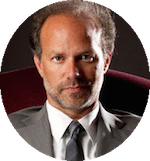136 East 57th Street Suite 1501
New York, NY 10022
Torn Shoulder Labrum Surgery

What is the Labrum?
The labrum is a type of cartilage found in the shoulder joint that is more fibrous or rigid than the cartilage on the ends of the ball and socket. The labrum is firmly attached around to the rim of the socket. The labrum has basically two functions: to deepen the socket to help the ball stay in place, and to act as an attachment for the ligaments that attach the ball to the socket. If the shoulder is injured, sometimes the labrum is pulled off of the rim of the bone as well. A common injury that orthopedic surgeons treat is a torn shoulder labrum.
Common Torn Shoulder Labrum Tears
Bankart Lesions:
This injury is the result of a shoulder dislocation or subluxation (partial dislocation). The labrum is torn off the socket as the ball comes out of joint. Sometimes the ligaments themselves can tear, but usually it is the labrum that tears with the ligaments attached. Usually when this happens the labrum does not heal back in the right location, making the ligaments loose and the shoulder more susceptible to future dislocations. Occasionally the bone will actually break off with the labrum and ligaments.
Torn Posterior Labrum:
A less common injury, but sometimes seen in athletes, this condition develops when the rotator cuff and labrum are pinched together in the back of the shoulder, making it difficult to rotate the shoulder inwards.

SLAP Tears:
This is most commonly seen in overhead and throwing athletes, such as baseball/softball, volleyball, swimmers and tennis players. The SLAP tear (Superior Labrum from Anterior to Posterior) occurs when the bicep tendon, which is attached at the top of the labrum and socket, peels off the labrum causing a tear with certain motions. Bankart and SLAP tears make it difficult to throw, serve or even lift heavy bags.

Diagnosis and Repair
Shoulder labrum tears are diagnosed on history and examination. There are very specific findings that make one suspicious for these injuries. Confirmation is usually with an MRI scan, which is a non-invasive non-radiation test, but occasionally requires an MRI arthrogram (an MRI scan with contrast dye injected into the joint before the MRI is done). The most accurate way of diagnosis is with an arthroscopy, when a small camera is inserted into the joint to look at it. This is usually done at the same time as the corrective procedure, though, as a shoulder or sports trained orthopedic surgeon can usually make the diagnosis without it.
Treatment for Torn Shoulder Labrum Tears
Treatment depends upon the kind of tear, age of the patient and goals of the patient. Sometimes these tears are managed successfully without surgery, but if surgery is necessary, it can be done arthroscopically. This means an excellent repair can be done with a small camera and specialized equipment that are inserted through very small incisions leaving virtually no scars but a solid repair. SLAP lesions may be trimmed or reattached depending on the configuration of tear while Bankart lesions need to be reattached to the socket to recreate the proper tension on the ligaments. This will prevent the shoulder from coming out of the socket. Dr. Noy uses outpatient arthroscopic techniques exclusively for these procedures, including knotless anchors which provide excellent strength of repair, and plastic surgery closures so that often the scars are barely visible.
Torn Shoulder Labrum Videos
Recovery from Torn Shoulder Labrum Surgery
For most repairs, typing on a computer and waist level activities are allowed immediately after arthroscopic repairs, allowing many patients to return to work within two days. Laborers and athletes obviously will take longer to get back to work as it takes at least four to six weeks for the labrum to heal back to the socket. It is during this time that the repair needs to be protected the most. Once the torn shoulder labrum is healed after surgery, a physical therapist will help you get range of motion and strength back over the next few months. Because of the variability in the injury and the type of repair done, it is difficult to predict how soon someone can to return to sports after the repair, but most patients are back to golf and regular activities fully at 3 months. Throwing is usually not started until 4-6 months, but we often will determine this by a strength test. The vast majority of patients have full function of the shoulder after labrum repair, and most patients can return to their previous level of sports with no restrictions.
Book Appointment
Let Prestige Orthopaedics & Sports Medicine bring you back to full strength.
Meet Our Founder Dr. Ron Noy
The founding mission of Prestige Orthopaedics & Sports Medicine is to provide safer, more effective and quicker recoveries with less pain and unrivaled service
Patient Testimonials
Read why patients think Prestige Orthopaedics & Sports Medicine is the leading New York City Orthopaedics Specialist. Filter through reviews from all online sources.







